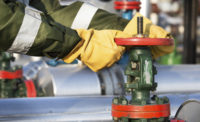The natural gas meter may be the textbook example of something that is said to be “hidden in plain sight.” Every structure – from house to hospital and grocery store to commercial warehouse – that uses natural gas as the feedstock for its furnaces, stoves or water heaters has at least one of the (usually) gray boxes bolted to its exterior.
These natural gas meters serve a critical purpose: they monitor the flow of natural gas into the facility and its rate of consumption. The natural gas is supplied by a gas utility company, with the amount consumed over a particular billing period, usually a month, recorded by the meter and then converted into a bill that the consumer must pay in order to keep receiving the natural gas service.
The most common type of natural gas meter has a diaphragm design in which two or more chambers are formed by movable diaphragms. These chambers alternately fill and discharge the in-flowing gas, creating a continuous flow rate. As the diaphragms fill and empty, a series of levers turn a crankshaft that allows the gas to flow into the building. The meters are outfitted with an odometer-like mechanism that records the amount of gas that is consumed. Other types of gas-meter designs include rotary, orifice, turbine and ultrasonic flow.
The one thing that all of these designs have in common, however, is that if the meter is damaged there is the possibility that a gas leak can occur as the unit is violently separated from the riser pipe that carries the gas into it. In these instances, the results can be catastrophic, ranging from a leak that can pollute the atmosphere to a fire or explosion that can result in the loss of life and property.
So, while thousands of people may walk or drive by natural gas meters on a daily basis and barely notice their existence, the meters must be protected from excessive-force incidents that can sever them from their supply lines.
The challenge
The most typical form of protection for a natural gas meter – at least at a high-traffic commercial or large residential structure such as an apartment building – is bollards, or a series of short, thick posts that are cemented into the ground in order to form a protective perimeter around the meter(s). Though bollards perform their duty well when confronted with an assault from a bicycle or runaway shopping cart, they are much less effective when a 4,000-pound vehicle crashes into them. When that happens, that aforementioned catastrophic natural gas leak is much more likely to occur. And when located at single-family residences or smaller commercial facilities, the natural gas meter will more likely than not have no bollard-like protection from outside forces.
An area of operation within the natural gas meter universe that has come under increased scrutiny in recent years revolves around what are known as “farm taps.” By definition, a farm tap is a “natural gas piping connection to an interstate or intrastate transmission and supply pipeline” that serves as a hub in the natural gas supply chain. These high-pressure connection points were once located in mainly rural areas of the United States, but more and more they are being situated in more heavily populated regions. This, of course, increases the chance that they may be damaged, which can, as mentioned above, result in a damaging fire or explosion that can also knock them out of commission for a period of time, meaning an interruption in supply for their users.
The regulation of farm taps falls under the purview of the Gas Distribution Integrity Management Program (DIMP) as overseen by the U.S. Department of Transportation’s Pipeline and Hazardous Materials Administration (PHMSA). Specifically, the DIMP regulations as they pertain to farm taps can be found in 49 CFR Part 192, Subpart P and § 192.740.
In general, the DIMP regulation dictates that the installation and operation of the farm tap must satisfy four requirements:
- It must be in good mechanical condition
- It must be adequate from the standpoint of capacity and reliability of operation for the service in which it is employed
- It must be set to control or relieve at the correct pressure consistent with its pressure limits and to limit the pressure on the inlet of the service-regulator gauge to 60 psi (4.1 bar) or less in case the upstream regulator fails to function properly
- It must be properly installed and protected from dirt, liquids or other conditions that might prevent proper operation
The fourth requirement makes it imperative that the farm-tap installation be protected from both the environment and potential high-force incidents that can damage it and lead to a damaging natural gas leak.
While farm taps can be especially vulnerable to damage, with the result oftentimes especially catastrophic in terms of damage and loss of supply, there are five other pain points that may result in natural gas meter leaks:
• Vehicle impact: This is particularly common in the parking lots of large facilities, along with roadways and alleys where crowded conditions or distracted drivers can lead to the meter being run into, which will cause the supply line to separate from the meter box. The result is a leak that will put everyone in the surrounding area in danger.
• Negligence: Befitting their “hidden in plain sight” traits, the needs of natural gas meter protection are often ignored when they are located in a storage area where tractors, lawn mowers, landscape equipment and other large pieces of heavy-duty equipment are stored. The possibility that a high-force incident will disconnect the meter from the supply line is always looming.
• Acts of nature: Falling snow (or unobservant snowplow drivers), ice and tree limbs, or the impact of high winds can damage gas meters at any time of day.
• Damaged bollards: Bollards are like the Secret Service, always ready to step in to protect the meter when threatened. Over time, if the bollards have been the subject of numerous collision incidents, they may become damaged, which will compromise their ability to provide proper protection for the meter. It is also not out of the question that a bollard that is run into will actually be the object that damages a meter box and causes a natural gas leak.
• Ground settlement: Over time, any shifts in the ground in which the gas-supply system is installed can cause the meter to shift, which will put stress on the supply lines that can compromise the connection to the meter box.
The solution
While bollards have been brave soldiers over the years in the battle to protect natural gas meters, they really only provide nominal protection and, as noted, can quite often be the actual cause of a gas-line rupture. Thankfully, an innovative solution is now available to assist the beleaguered bollard in the never-ending struggle to keep natural gas meters safe and leak-free.
This innovation is an innovative valve that creates an intentional weak point in the piping assembly, which results in an engineered point in the riser pipe that will break at that point when a high-lateral-impact incident occurs. Because of their rigidity the risers and piping associated with natural gas meters can easily break upon impact.
As the valve disconnects upon impact, a ball inside the fitting is pushed by a force-loaded spring into the area where the valve has separated from the meter. The ball acts as a plug that instantly stops the escape of gas from the supply line. With the flow of gas halted, the risk of fire, explosion, property damage and serious personal injury is eliminated, as well as the loss of saleable gas to the atmosphere.
This technology is perfect for applications where bollards may not be practical, but it can also be used in conjunction with a bollarded setup, which will provide an even higher level of protection for the gas meter.
Conclusion
It’s probably fine that natural gas meters are generally ignored by the public, as long as they operate properly and function as the best way to help accurately bill their users for the natural gas that is consumed. But when a meter is damaged – be it by high-force accident, act of nature or plain old neglect – the consequences can be severe. While bollards remain the most popular way to protect them, new technology takes that level of protection to an elevated level. Thanks to innovative design that immediately halts gas flow in the case of a high-force incident, the days of leaking meters that can lead to fires and explosions may soon be a thing of the past, even in high-pressure farm-tap supply applications.



